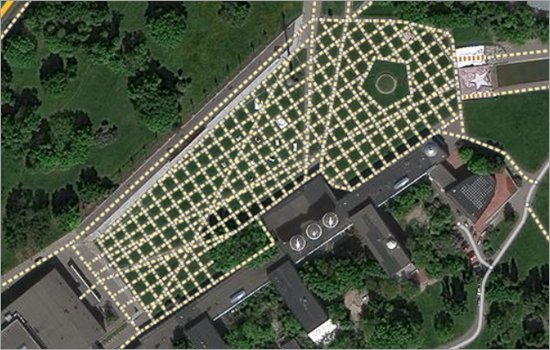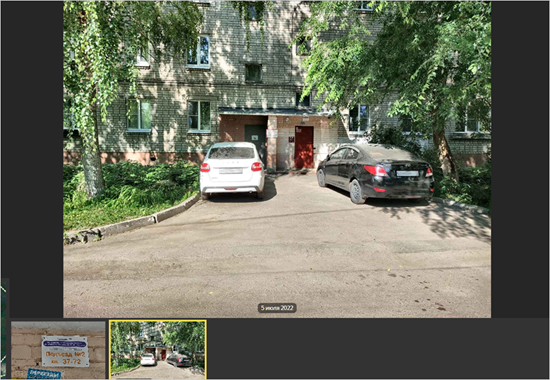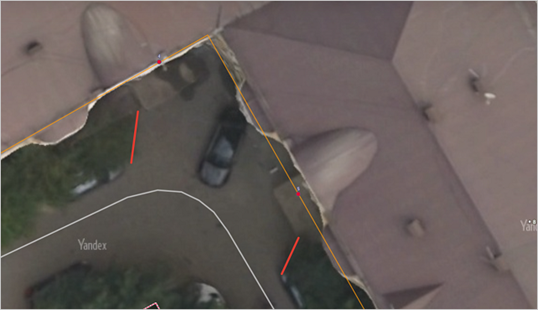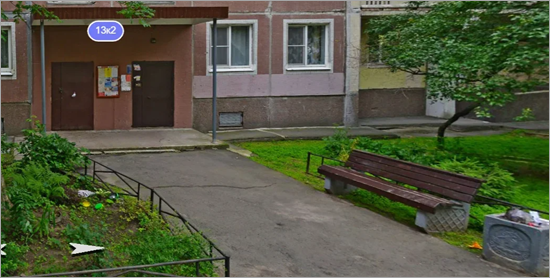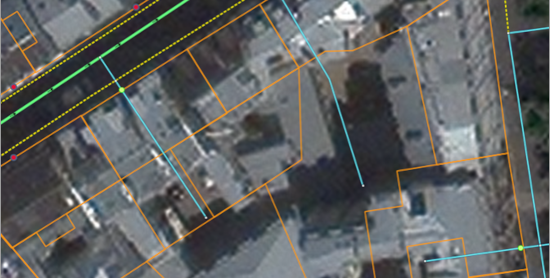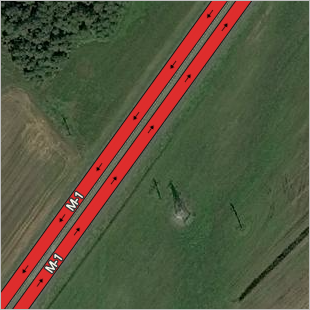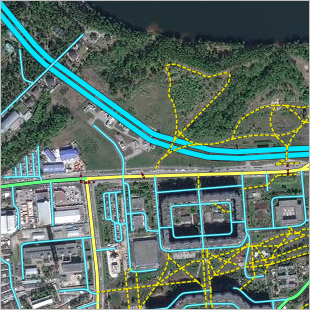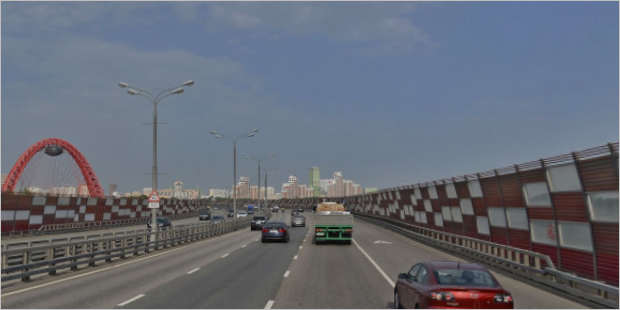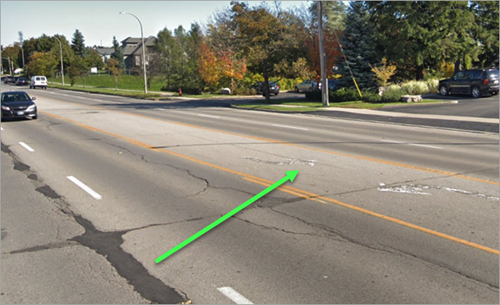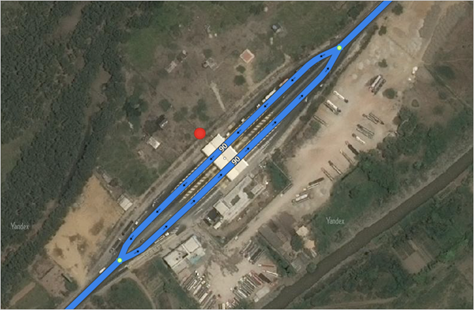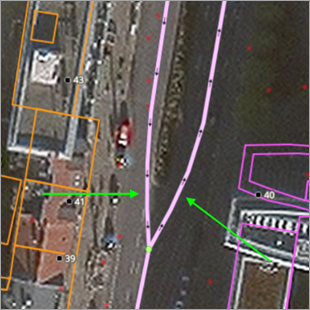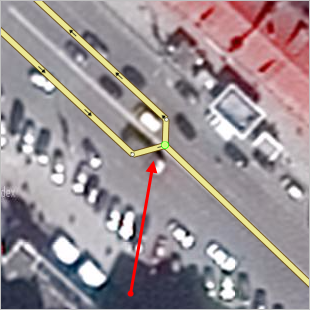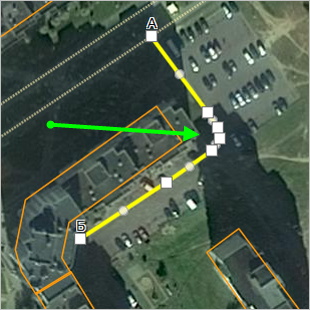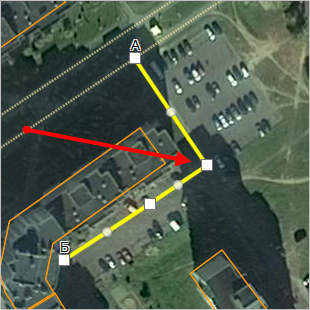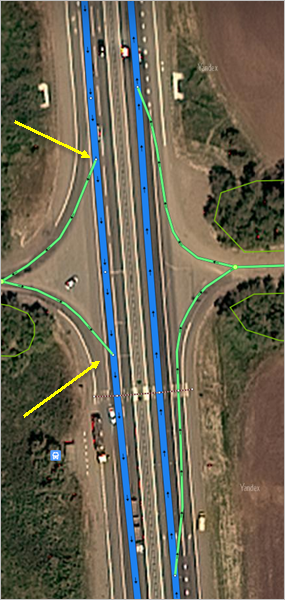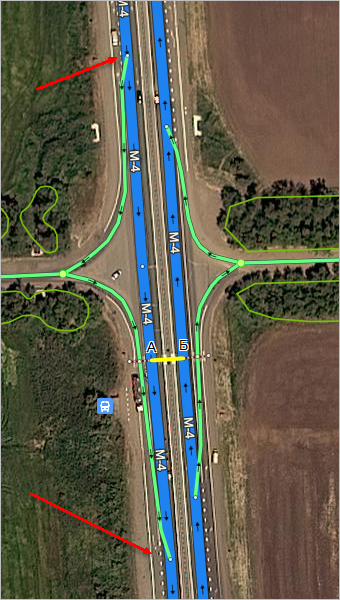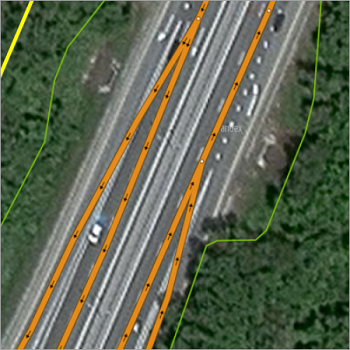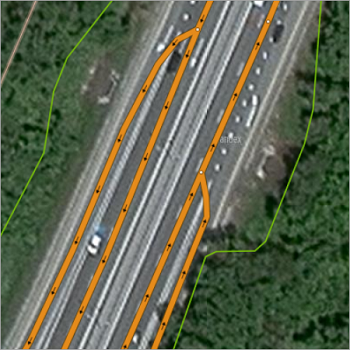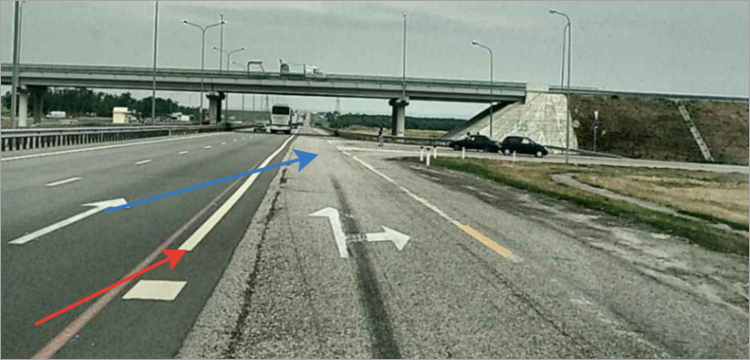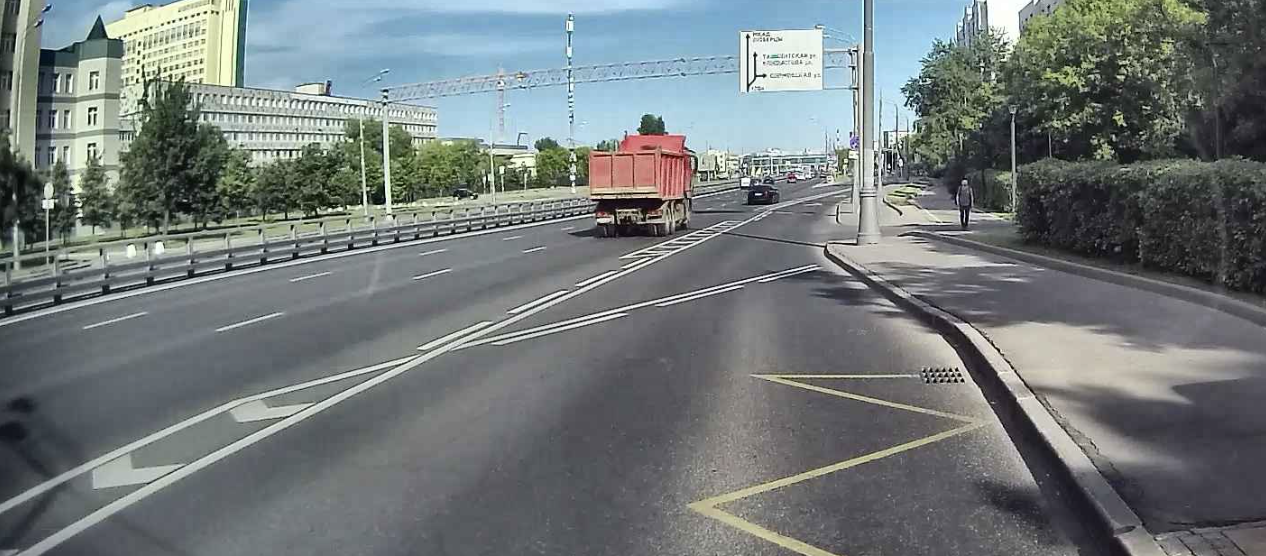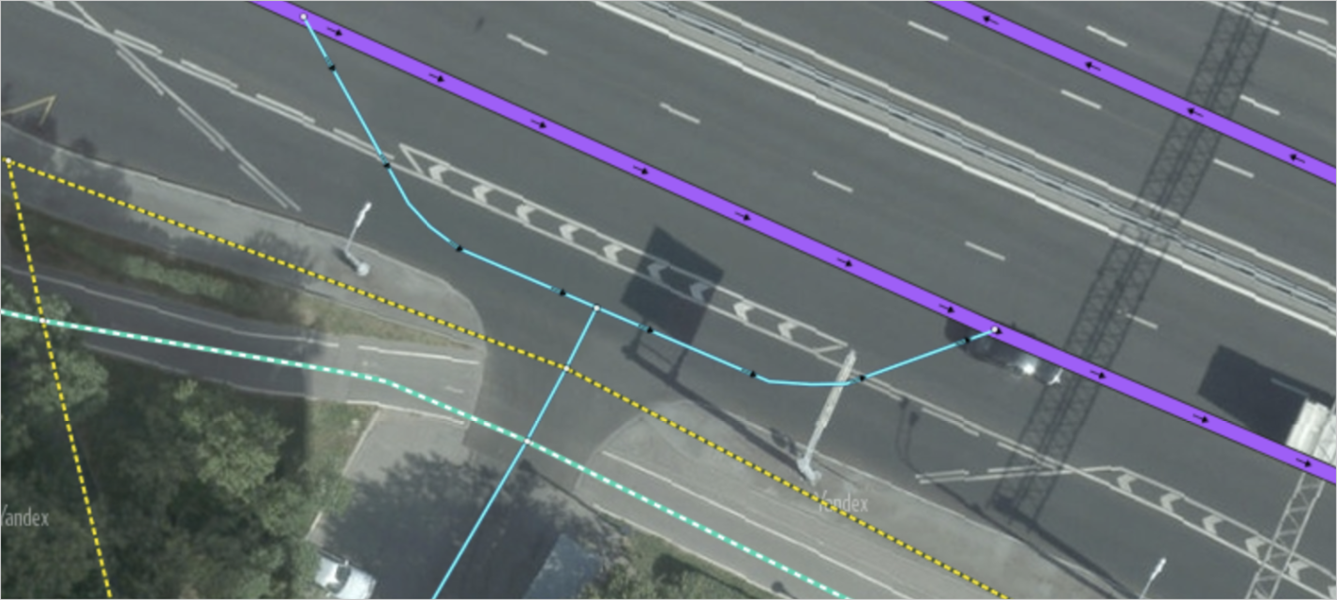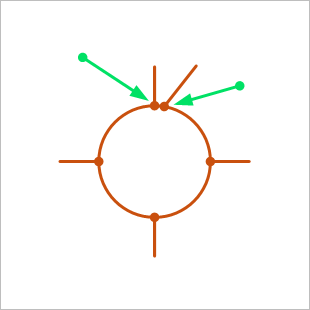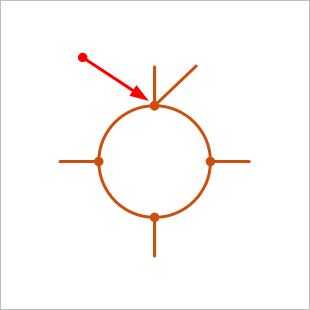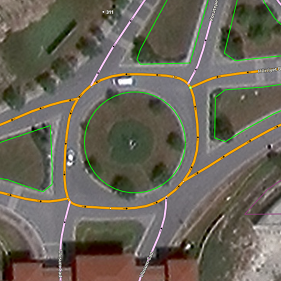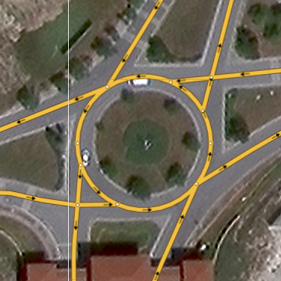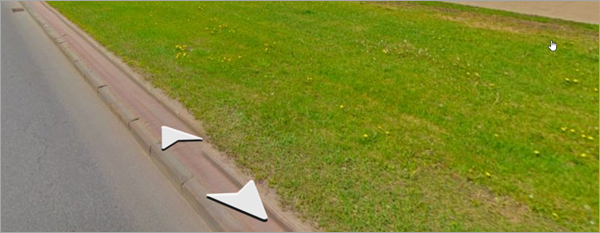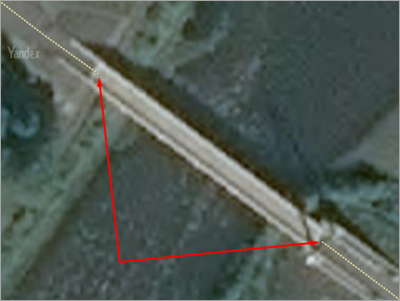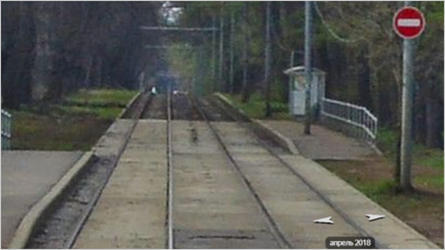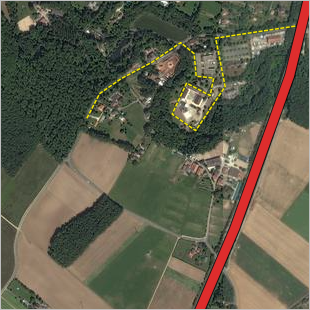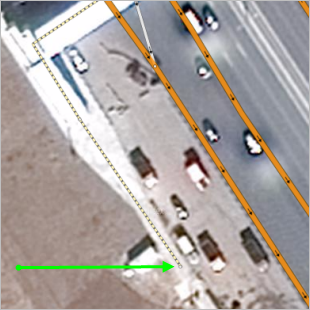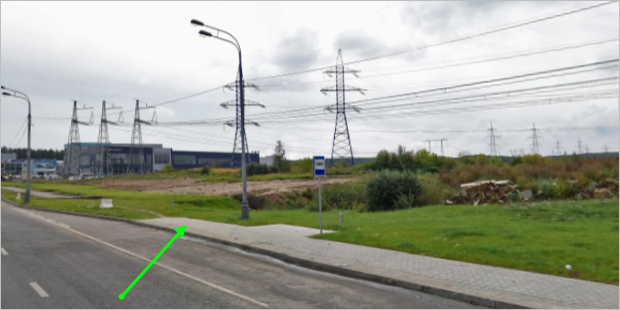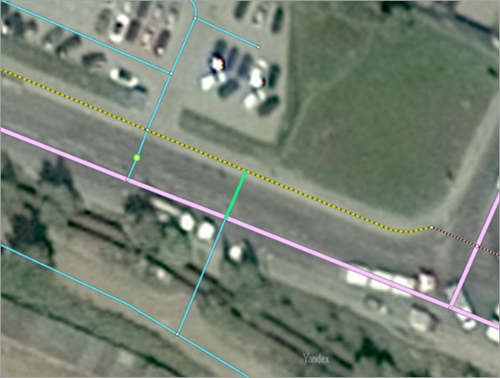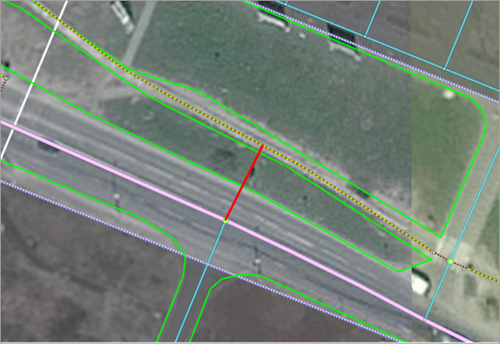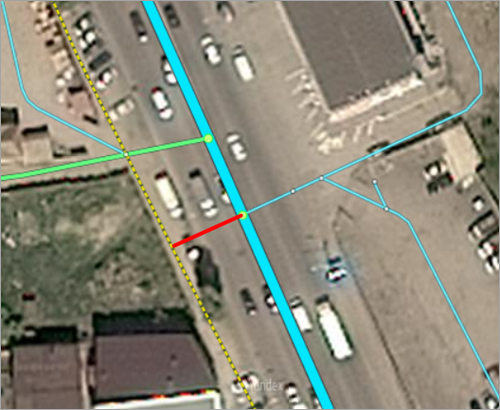3.3.1. Rules for drawing roads and sections of road
- 3.3.1.1. Drawing rules for whole road networks
- 3.3.1.2. Rules for drawing roads in one/two arcs (one or two lines)
- 3.3.1.3. Rules for drawing straight and curved road sections and turns
- 3.3.1.4. Rules for drawing u-turns with two lines
- 3.3.1.5. Rules for drawing intersections
- 3.3.1.6. Drawing rules for sidewalks, pedestrian paths, and bike paths
- 3.3.1.7. Rules for drawing seasonal roads
Be careful when drawing roads. The road network is used to set routes, so drawing errors can lead to routing mistakes.
Techniques for drawing and editing road sections are similar to the techniques for drawing and editing all linear items on YME.
For their descriptions, see Sections 2.6.1.1. Drawing simple linear objects and 2.6.1.2. Editing simple linear objects.
There is a tool for drawing circular road sections.
When you draw a road section, keep in mind that certain drawing rules relate to features of the road in question (rather than to that particular road section). For example, some roads are drawn with a single line and others with two lines (for more information, see Section 3.3.1.2. Rules for drawing roads in one/two arcs (one or two lines)).
This is why the drawing rules for sections of road include:
- Drawing rules for roads and whole road networks:
When drawing road elements, the points where the road elements intersect (the start or end point of each element) form independent objects of type “Intersection”. Intersections are created automatically when drawing road sections and can be used to edit the road network (for more information, see Section 2.9. Intersections.) and to set road conditions, traffic lights, and speed cameras.
When drawing roads, do not create road sections and their intersection boundaries excessively. The start and end points of road sections must overlap:
— With intersections
— With points where road section attributes change their values (such as changes in speed limits, or a road section passing the boundary of another traffic installation like a bridge or a tunnel, etc.)
— With a number of Places, such as:
3.3.1.1. Drawing rules for whole road networks
- 3.3.1.1.1
-
Road networks should be connected: all fragments of a road network that forms in a given area should be connected on the map. For example:
Correct Incorrect 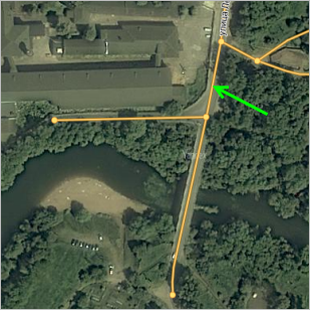
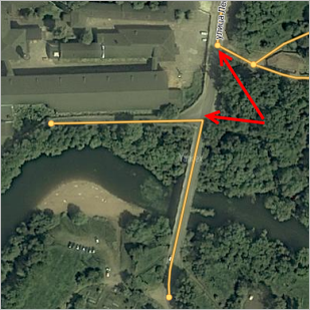
Correct Incorrect 

In a connected road graph, road sections are connected both geographically and in terms of attributes, which means various types of vehicles are able to use them.
If a certain type of vehicle can't get to or leave a road network section which it is not located in a large restricted area or an isolated terrain item, this section is considered excluded from the connected road network and requires editing its geography or attributes.
Note. Pedestrian road sections that are inaccessible to bicycles are not excluded from bicycle routing and are not considered isolated.If you can only get to a certain “isolated” road section by railroad or ferry crossing (but not by motorway), then the road network should include these railroad and ferry crossings, and you should add attributes to them accordingly (see Section 3.3.2.6. Type of structure).
Roads that are under construction can be connected to road networks via lower-class roads (see point 3.2.11).
Note. Road sections with timed maneuver restrictions are not considered to be isolated from the road network.When extending roads in areas where the road network is shifted relative to the satellite image, it's preferable to align existing roads with the satellite image, but it's not required to do so. In this case, new sections should be drawn with approximately the same shift as the road network at that location.
- 3.3.1.1.2
-
When you draw the road network, make sure that you don't overlap different road sections, draw a section that intersects with itself, or duplicate road sections:
Correct Incorrect 
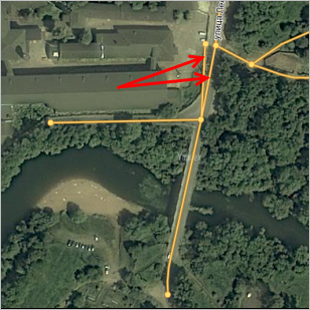
Correct Incorrect 

When you draw an item on the map, the program monitors if the drawing is correct and reports any errors to you:
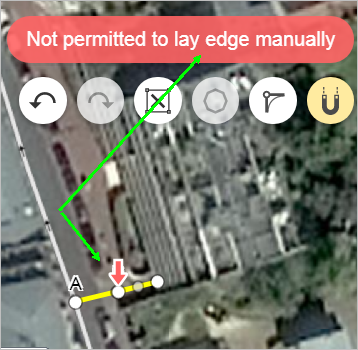
But not all errors are recognized automatically.
- 3.3.1.1.3
-
When you draw bends in roads or intersections, the end points of road sections that form crossings should meet and form an intersection. There should not be any “hanging points” (other than in cases where the road is blocked in that area):
Correct Incorrect 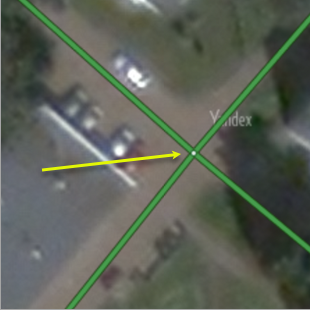
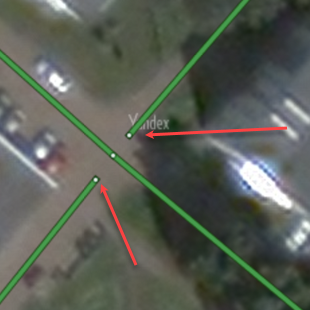
Correct Incorrect 
 Note.
Note.When redrawing roads, do not move “extra” lines of the road network from the roadbed. If there are service objects preventing you from removing extra lines of the road network, leave its geometric form unchanged.
- 3.3.1.1.4
-
Draw the road network based on satellite images.
If the satellite image is offset relative to tracks, then the staff must adjust the roads based on track information (for example, when there is a discrepancy between the track line and the central line of the roadway, and tracks aren't located within the roadbed in the image due to the terrain).
This tool is available to employees only.
When drawing two-way roads as a single line, draw the road line along the lane marking that divides oncoming passenger car traffic. When there's no marking, use the geometric center of the roadbed.
When drawing two-lane and one-way roads, draw road lines along the geometric center of the lanes intended for traffic, including tram tracks where cars are allowed to travel (ignore taxi and public transport lanes). Roads with an even number of lanes to be considered while drawing should be drawn according to the road markings that approximately coincide with the geometric center of the lanes.
You shouldn't shift the road line for turnouts or additional lanes for turning before intersections.
When you draw road sections that go over bridges, pay attention to the displacement of the bridge on the satellite image (for more information, see Section 2.3.1.4. Bridges).
If the images are significantly displaced from the tracks, don't manually edit the geometry of the road network, instead reporting the large-scale shift using the feedback form.
- 3.3.1.1.5
-
You don't have to include certain minor details in your drawing of the road network.
For instance, you shouldn't draw individual entrances to every home in a private development:
Correct Incorrect 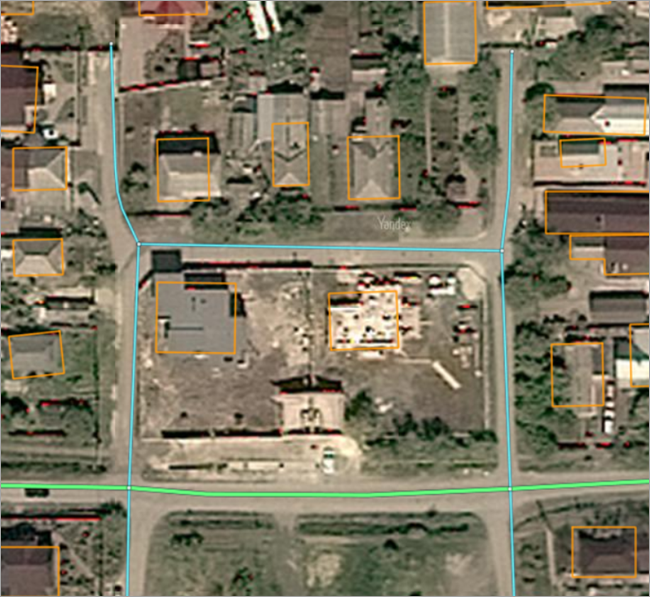
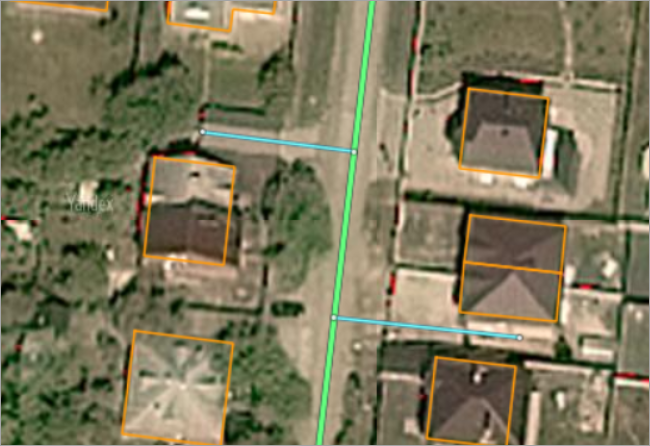
Correct Incorrect 

- 3.3.1.1.6
-
Only draw roads leading to roofs for buildings that belong to the “utility and storage” or "Stylobate" type.
Only draw roads in underground and multi-level parking lots in the following cases:- The parking area is located under a shopping or business center or there are no buildings above the parking area.
The public parking area is located in a “utility and storage” building, and the road doesn't lead outside the premises (in such cases, the minimum number of roads connecting all entrances and exits to the building can be drawn):
Correct Incorrect 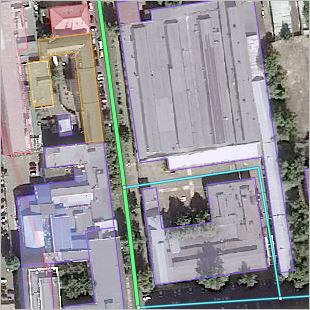
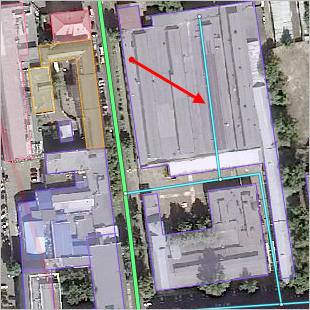
Correct Incorrect 

The one-way entrance and exit from the underground parking are located in close proximity to each other (in this case, the entrance and exit sections should be connected in an arc within the structure without leading them deep into the building):
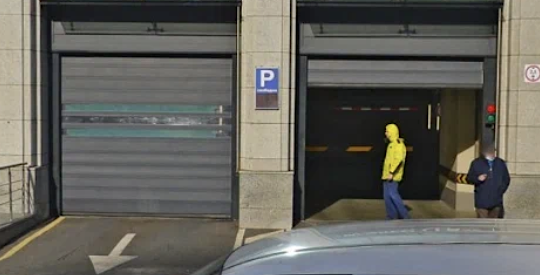
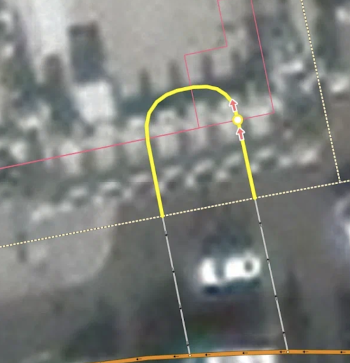
To ensure connectivity between roads on one-way entrances to and exits from underground parking lots, set the traffic to A ⇆ B if the roads are not located close to each other and cut off near a building's polygon.
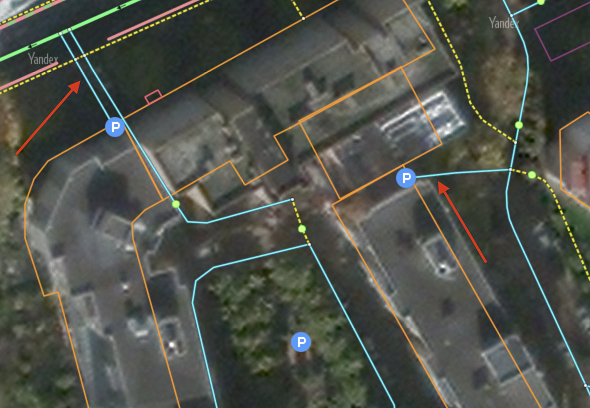
- 3.3.1.1.7
-
Road sections that cross country borders are cut at the point of crossing. The crossing is marked as an Intersection:
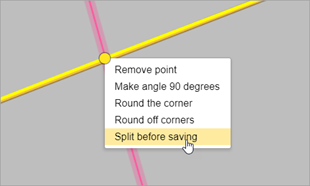
Motorways that pass through several countries (which are usually Numbered highways, such as M-1 Belarus or M-2 Crimea), are cut at crossings into sections running through different territories (also see Section 3.3.3.1.1).
This allows you to link the road to the administrative division (country) where it is located. The road will be divided into fragments that correspond to the territories of the different countries that it runs through:
- 3.3.1.1.8
-
Outside of continually developed areas, you may draw railways and single-lane roads as intersecting vegetation.
Within continually developed areas, you may draw single-lane roads as intersecting vegetation if they go through this vegetation and belong to one of the following classes:
- 10 (Pedestrian and bike paths).
- 9 (Field and forest roads).
- 8 (Driveways).
- 7 (Roads of minimal significance) accessible only to pedestrians and/or bicyclists.
Both outside of within continually developed areas, vegetation of the “Park, square”, “Nature reserve” and “Cemetery” types may intersect single-lane roads of any type if these roads are exit ramps to these areas of vegetation or passages through said areas.
See also 3.9.1.5.
- 3.3.1.1.9
-
When you draw roads that intersect with locality borders, you must split the border at the intersection point (creating two road sections).
Note.Streets linked to a locality should be located entirely within the borders of that locality. See 3.3.1.4.
- 3.3.1.1.10
-
Don't change the main road's shape if you're drawing the road expanding and getting new lanes near toll booths and border checkpoints. Checkpoint passages don't need dedicated lanes.
In addition, don't use separate sections to draw widening roads at entrances to shopping malls, airports, and other facilities if entering or remaining on these premises requires subsequent payment.
Correct:
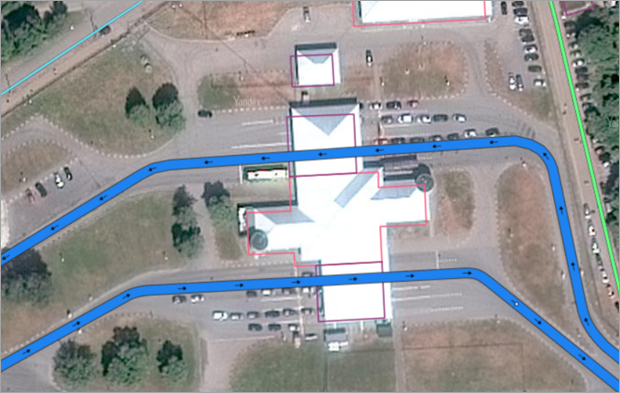
Incorrect:
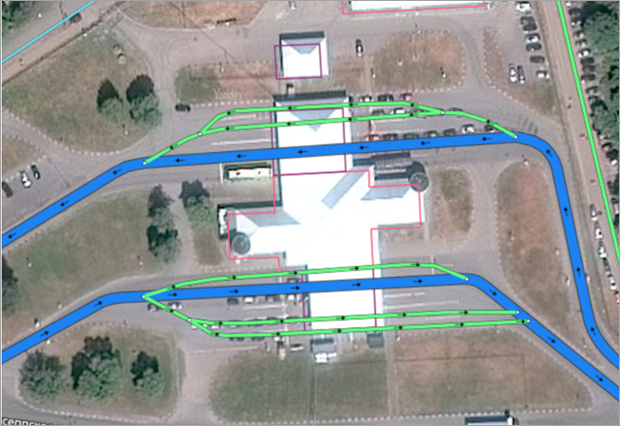
- 3.3.1.1.11
- Draw a U-turn site for public transport along the site's perimeter using the line of a class 8 road, which is one-way in the direction of public transport movement and accessible only to public transport in the following cases:
- The u-turn site is separated from the main roadway by marking.
- The u-turn site largely extends the roadway and includes a stop or parking area for public transport.
Correct Incorrect 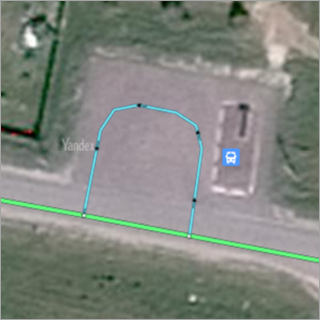
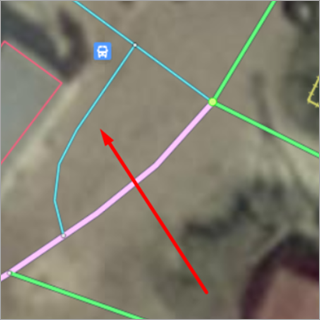
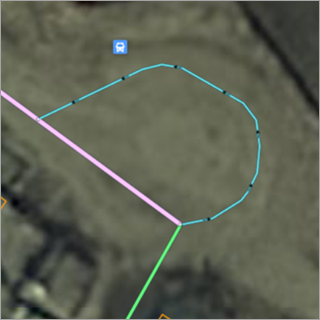
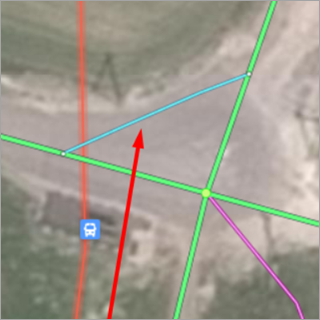
Correct Incorrect 



- 3.3.1.1.12
-
Areas leading to filling stations should be drawn using class 8 road sections, even if they aren't separated from the main road by barriers or markings.
- 3.3.1.1.13
-
When drawing or editing lines of the road network, you should also create or edit maneuvers in cases regulated by point 3.3.4. Traffic conditions.
- 3.3.1.1.14
-
If a reconstruction or change in the traffic pattern renders a road section inaccessible (due to a physical obstacle, signs, or road marking), such a section should be marked with the attribute Under construction.
- 3.3.1.1.15
-
When drawing road sections that pass through Road structures, the recommended practice is to draw these structures as well.
3.3.1.2. Rules for drawing roads in one/two arcs (one or two lines)
There are two ways to draw roads on Yandex Map Editor:
In “one line” (for both one-way and two-way roads):
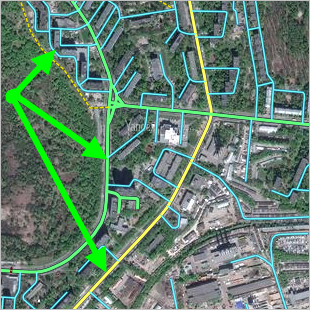
In “two lines” (one representing each traffic direction):
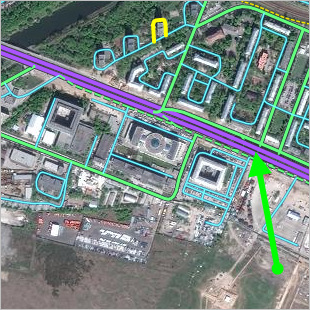
- 3.3.1.2.1. Two-lane drawing
-
Always use two lanes to draw road sections that are separated by a physical barrier:
- a) A barrier or dividing road posts:
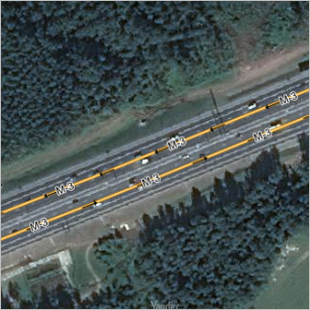
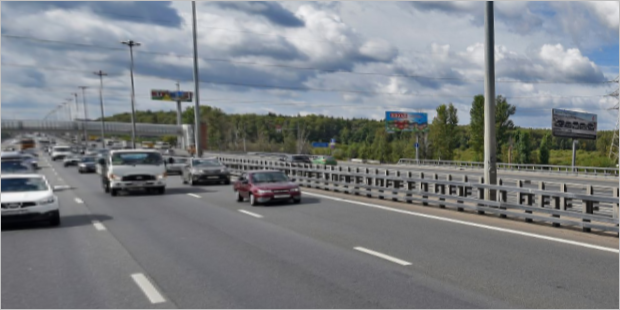
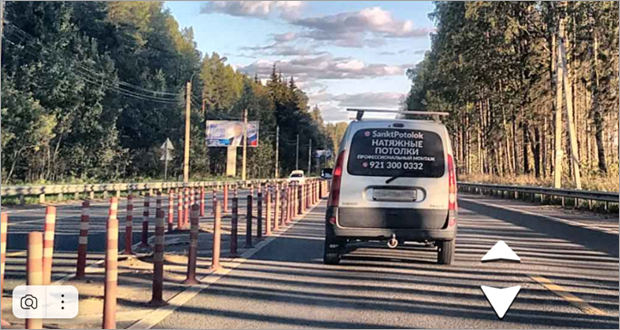
- b) Lawn, flowerbed:
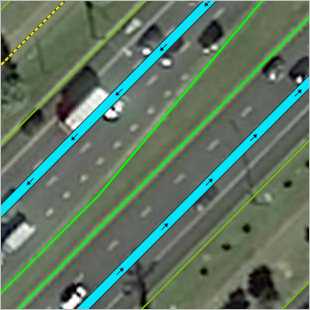
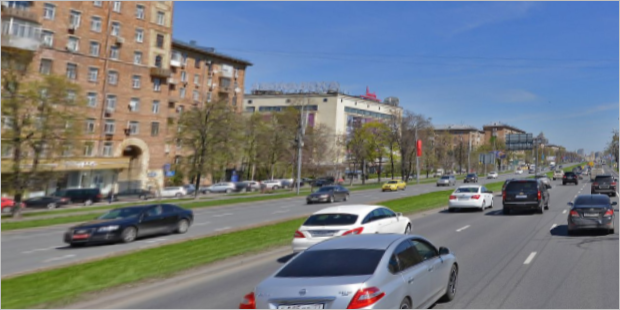
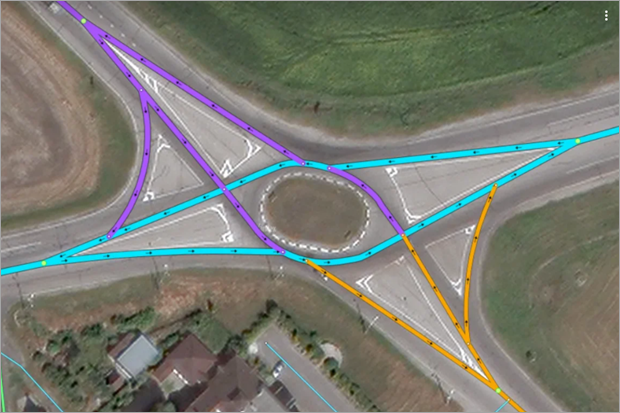
- c) Tram tracks vehicles can't or aren't permitted to drive to (elevated above the road or separated by a solid line):
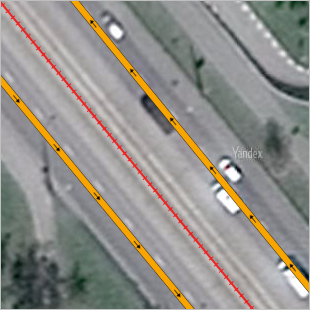
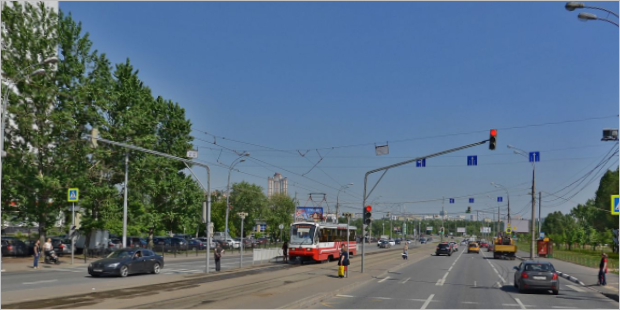
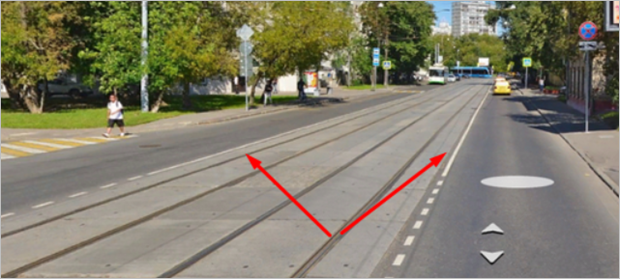
Furthermore, using two lanes is preferable but not required in the following cases:
- 3.3.1.2.2. One-lane drawing
-
Draw all roads that don't meet the criteria for having two lanes (see 3.3.1.2.1) using one lane.
- 3.3.1.2.2.1
-
Don't draw additional road lanes for a marked lane of oncoming or same-direction traffic of public transport:
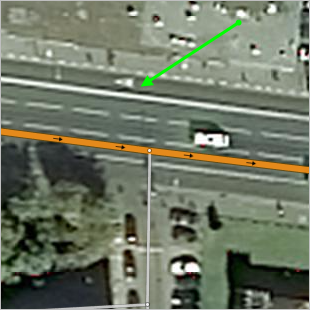
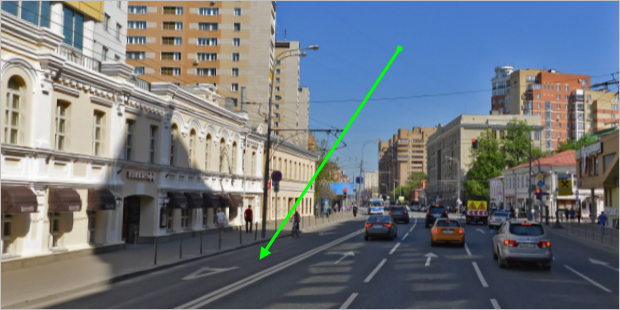
- 3.3.1.2.3
-
If a road has multi-level interchanges, then draw the interchanges as you would the road itself (with either one or two lanes):
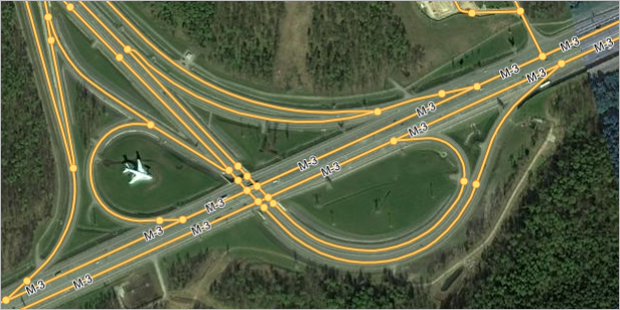
- 3.3.1.2.4
-
For a short section of road, you should not switch between drawing one and two lines (even if the number of lanes or the road markings change). Within localities, a section less than one block long is considered a short section.
If the road has a physical divider, draw it using two lines. An exception to this rule is cases when a pair of items that physically separate traffic lanes (forming a “traffic island” at a pedestrian crossing) are positioned at a distance from each other that is less than or approximately equal to the width of the pedestrian crossing. For example, a pair of traffic lights or borders does not change the rendering of a single-lane road to a two-lane road:
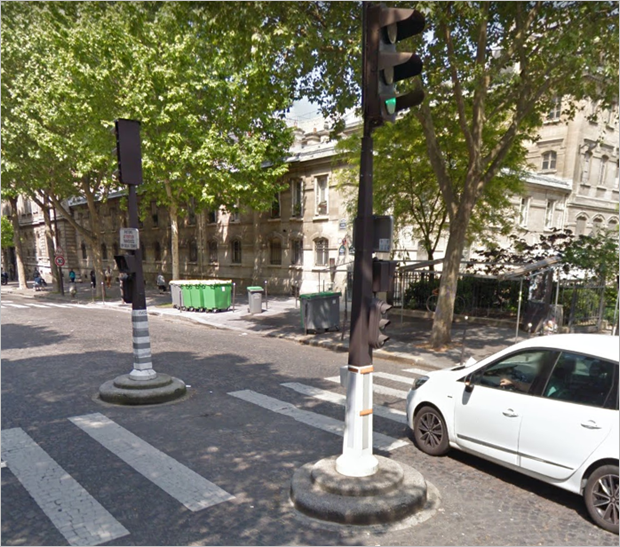
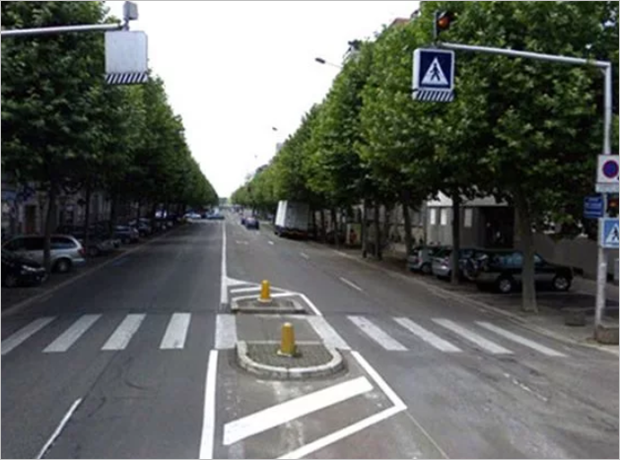
You should not switch your drawing method for marked breaks in a solid double line or for a traffic island before an intersection:
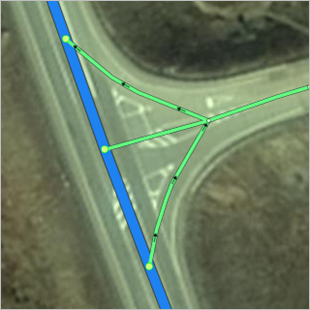
- 3.3.1.2.5
-
Sections of road drawn using two lines should run parallel to each other if they are parallel in reality (green arrow on the drawing). Areas where the road narrows or widens are an exception to this rule (blue arrow on the drawing):
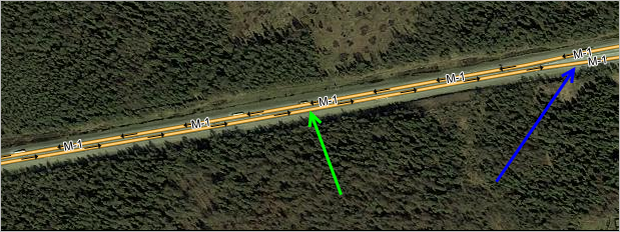
3.3.1.3. Rules for drawing straight and curved road sections and turns
Rules for drawing straight and curved road sections (these rules supplement the general rules for drawing linear items):
- 3.3.1.3.1. Drawing straight sections of road
-
Straight sections of road should not have intermediate vertexes:
Correct Incorrect 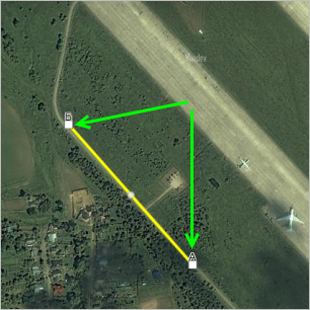
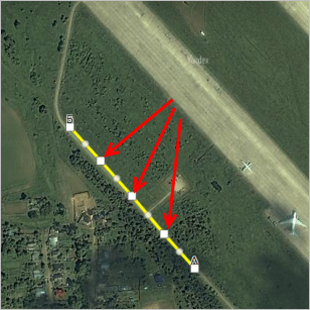
Correct Incorrect 

- 3.3.1.3.2. Drawing curved sections of road
-
On curved sections of road, the number of vertexes should be sufficient so that angles at slight turns are not noticeable on maps at scale 18. You should not draw more points than are necessary to fulfill this requirement:
Correct Incorrect 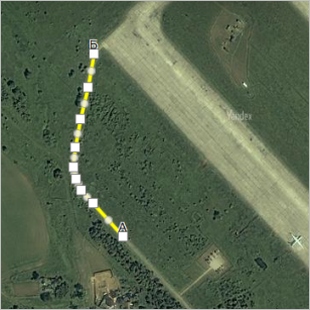
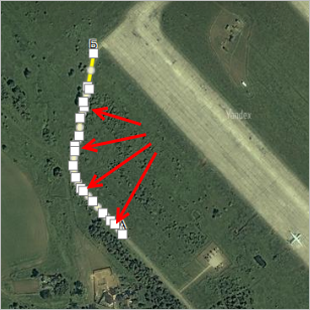
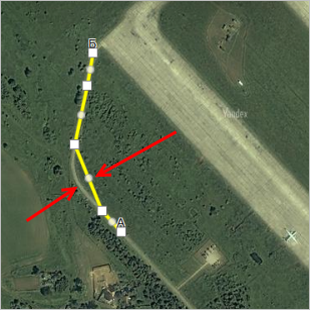
Correct Incorrect 

 Note.
Note.Pedestrian roads should be drawn preserving their actual geometry: you may draw unsmoothed angles if this is consistent with the road's actual geometry (for example, its boundaries are marked with a curb).
- 3.3.1.3.3. Drawing turns
-
Draw turns so they look smooth (with no angles) when viewed on a map at scale 18.
3.3.1.4. Rules for drawing u-turns with two lines
If a road drawn using two lines has a u-turn:
- 3.3.1.4.1
-
Draw a two-way u-turn in fragments that run perpendicular to the lanes you drew on the road.
If the u-turn lanes are separated from one another (by a barrier, median, lawn, or traffic island entered as markup), then draw the u-turn using two lines:
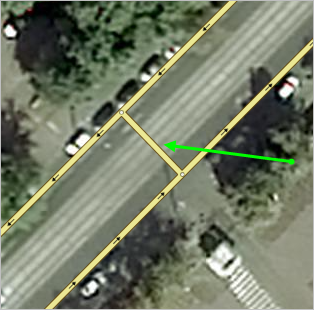
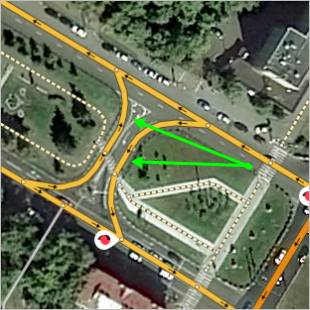


- 3.3.1.4.2
-
Draw one-way u-turns as arcs and indicate the traffic direction:
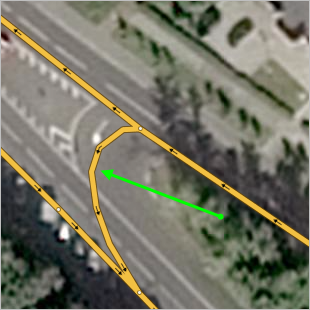
The intersection with the main road should be drawn where the dashed line turns solid.
- 3.3.1.4.3
-
You can use a separate line of the road network to draw U-turn sections located before an intersection, provided that u-turn directly at the intersection is restricted by the traffic rules.
In the drawing, the U-turn at the intersection is impossible due to the one-way line of the road: the direction of movement does not allow you to turn left to make a U-turn.

3.3.1.5. Rules for drawing intersections
Draw intersections to reflect the actual traffic situation there (in other words, take traffic signs, permitted turns, etc. into account regardless of if the roads that intersect there are drawn using one or two lines).
The following rules apply for drawing intersections:
- 3.3.1.5.1
-
If a road intersects with two different roads that only differ by name (in other words, the driver can navigate from one to the other without performing any maneuvers), then enter one general intersection point that applies to both of them (see upper drawing).
If this is not the case, then enter two intersection points (see lower drawing):
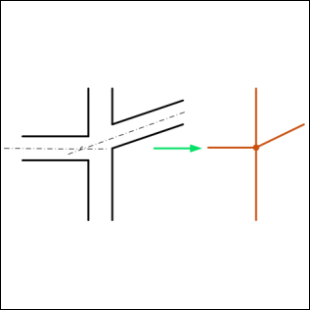
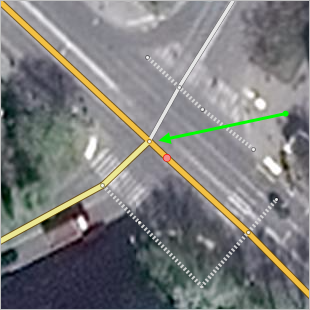
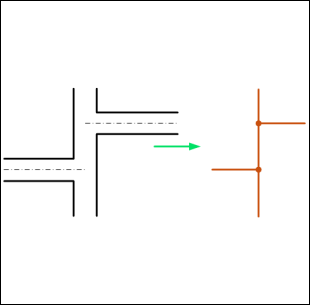
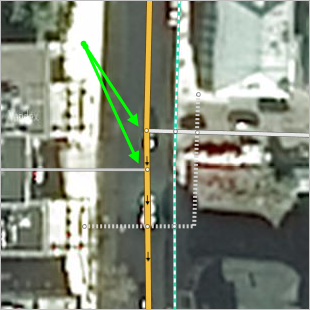




- 3.3.1.5.2
-
Only draw turns (or exits) at intersections as well as exits and dedicated lanes that run parallel to the main road as separate lanes when they are physically separated from the main roadway (by a barrier, median, or lawn) or one of the following types of road markings:
- Traffic island.
- Solid line, bus lane, or bike lane.
- Double solid line.
Note.Don't draw exit ramps for roads that widen by one or two lanes before an intersection.
Examples of cases where you show draw an exit ramp:
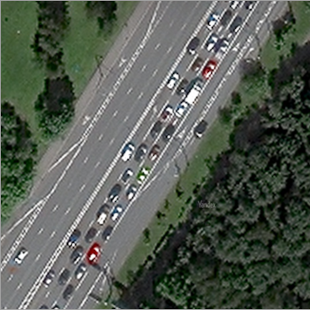
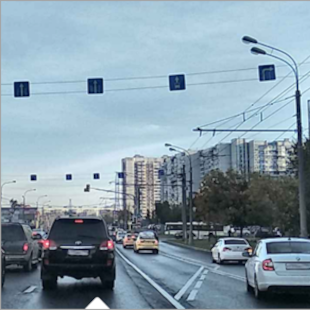
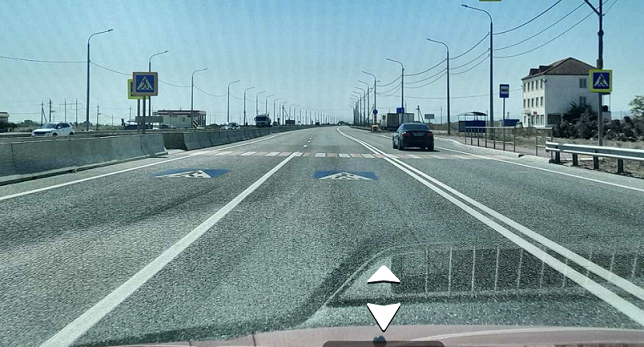
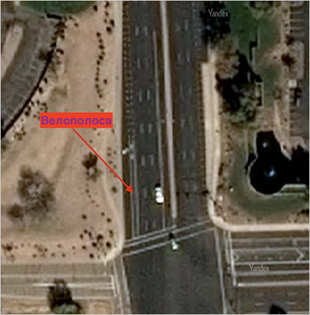




Examples of correct and incorrect exit ramp drawing:
Correct Incorrect 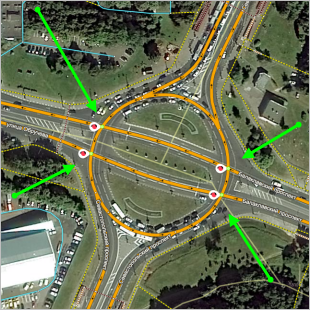
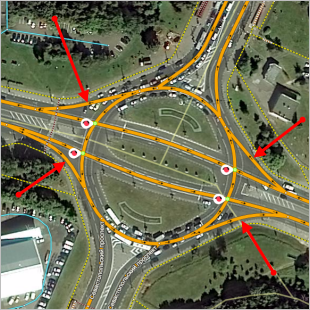
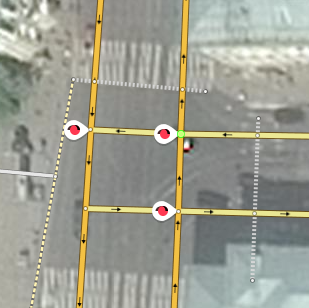
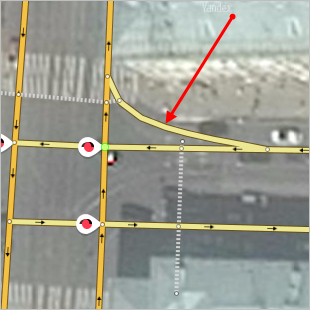
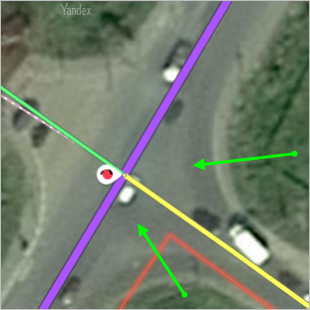
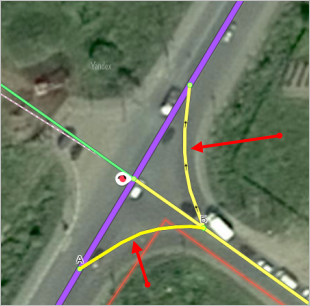
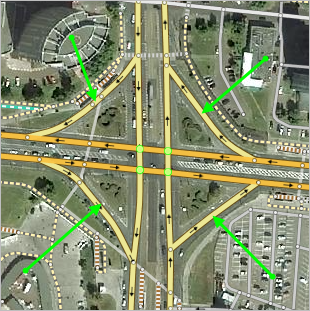
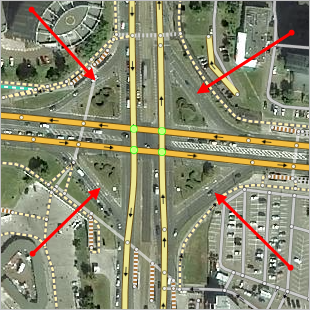
Correct Incorrect 







Example of a correct exit ramp drawing when there is a physical barrier:
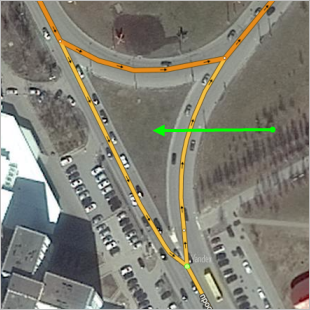
Examples of complex interchanges in the UAE that require drawing separate lines for exits:
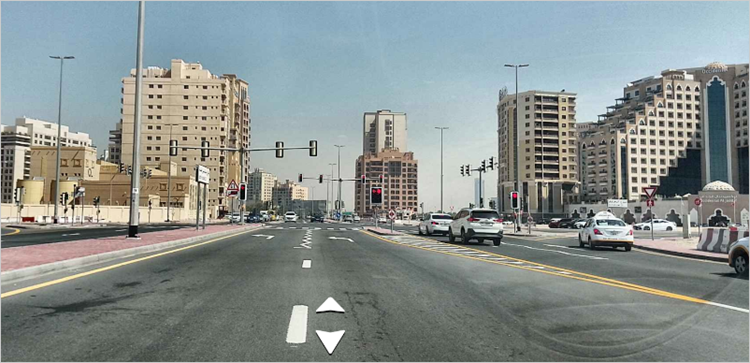
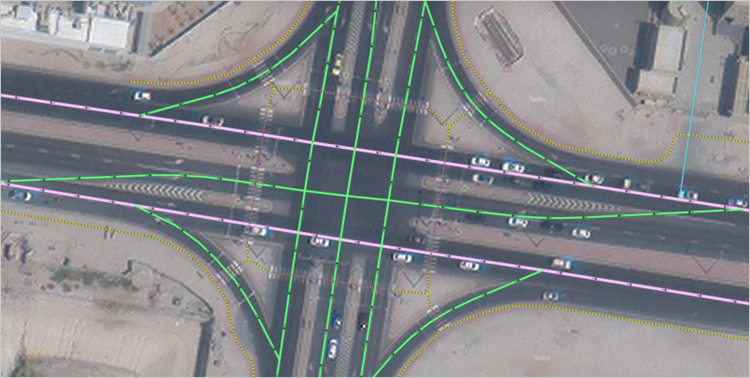
- 3.3.1.5.2.1
-
If the exit is essentially a separate lane (which means vehicles can't move in any directions other than the exit), draw the intersection with the main road at the point where the dashed line becomes solid to separate the lane vehicles can use to move in the main direction.
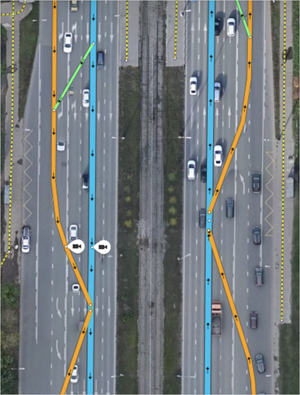
If the exit is marked only by a traffic island without solid line markings, draw it along the central line of the roadbed from the beginning of the traffic island, then connect it to the main road in as short a distance but as smoothly as possible.
Correct:
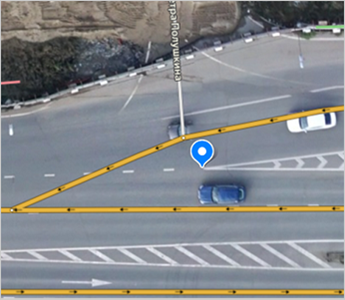
Incorrect:
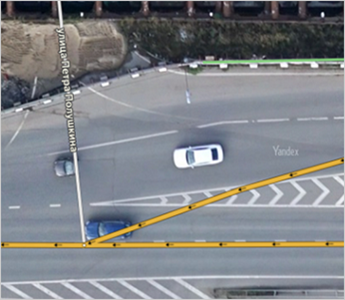
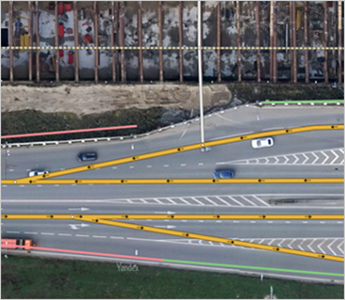
- 3.3.1.5.2.2
-
If there's a section between the exits specifically allocated for public transport (and taxis if there are no additional signs), draw the exits according to the general rule (without artificial rounding):
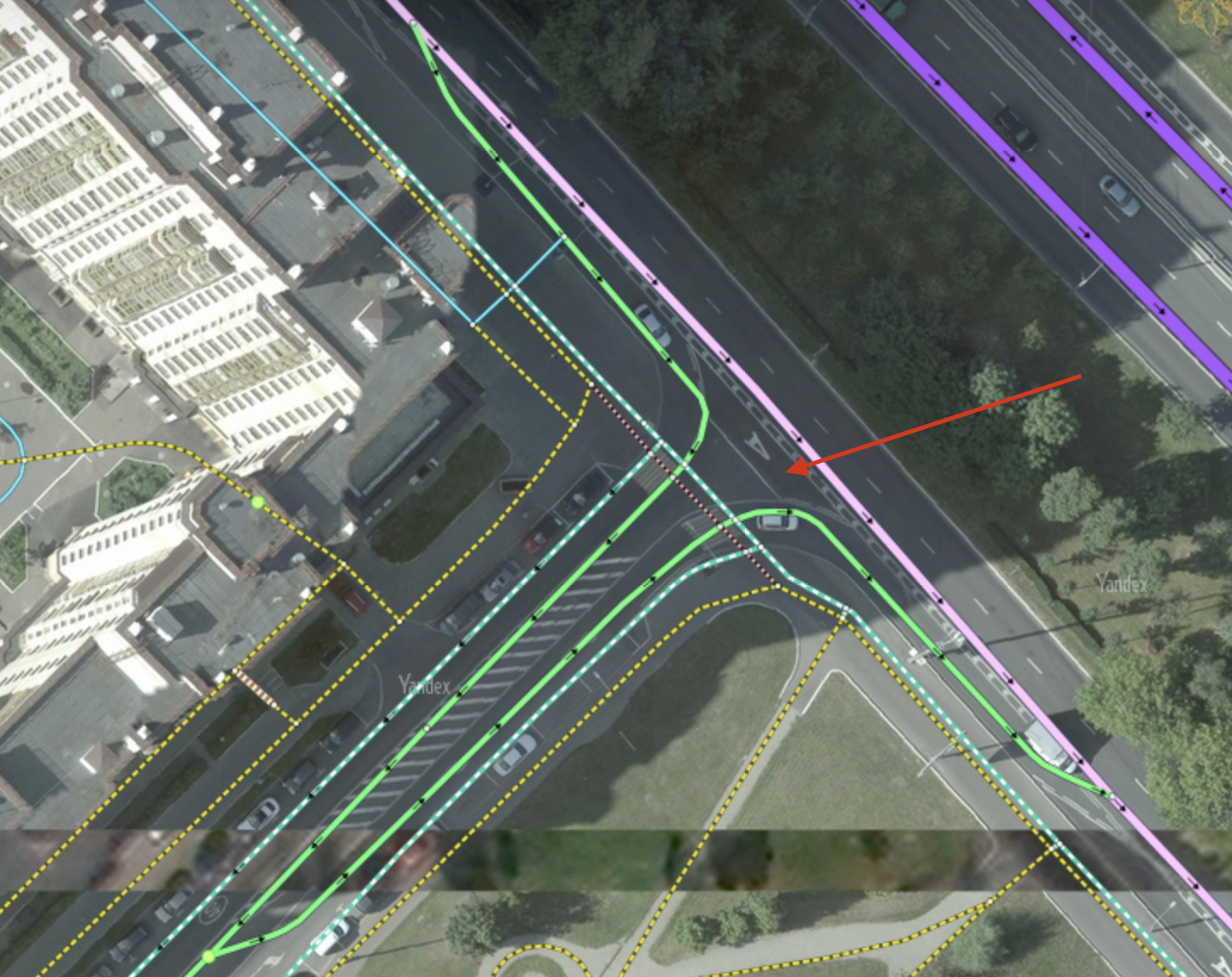
- 3.3.1.5.3
-
When drawing intersections with a combination of one- and two-lane roads, convergence of two-lane roads into one-lane roads within the intersection is prohibited:
Incorrect Incorrect 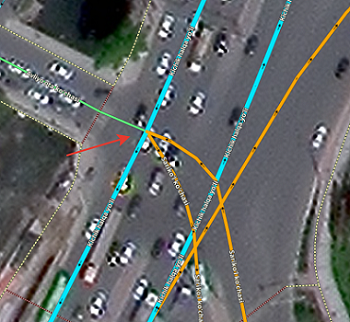
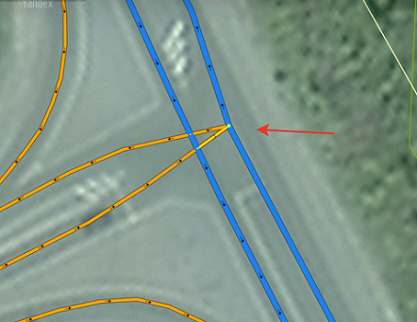
Incorrect Incorrect 

- 3.3.1.5.3.1
-
At the intersection of two-way roads, we recommend converging a two-lane road into a one-lane road after the crossing of the road network sections (after the intersection). But you may also draw convergence before these sections cross (that is, before the intersection).
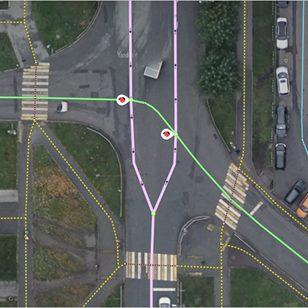
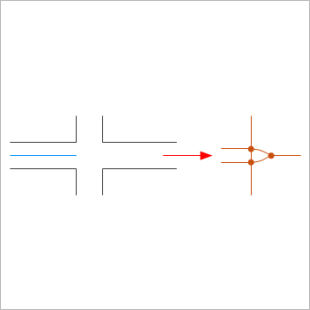

 Attention.
Attention.Make the convergence of a two-lane road into a one-lane one smooth (see point 3.3.1.2.4).
Note. If a road section behind the intersection is intended only for public transport, draw it on the map and set its class to 7 (Roads of minimal significance):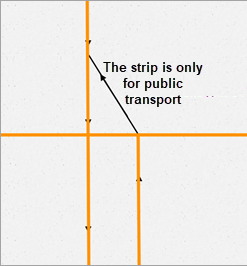
If two two-lane roads and one one-lane, one-way road approach an intersection, then the convergence of the two-lane road into one-lane is not drawn down the middle of the road, but rather as indicated in the drawing on the left (the green arrows indicate the permitted traffic directions):
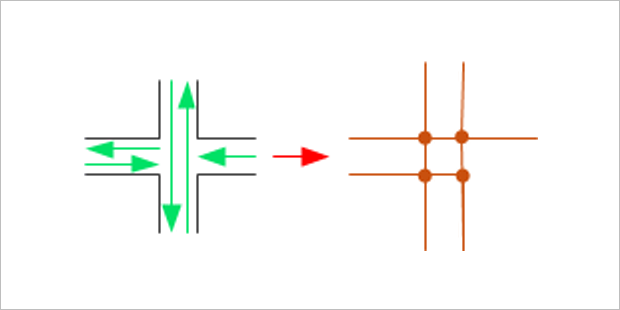
- 3.3.1.5.3.2
-
If two two-lane roads (and one or two one-lane roads) approach an intersection, then we recommend converging these roads into a one-lane road after the intersection. But you may also do it before the intersection:
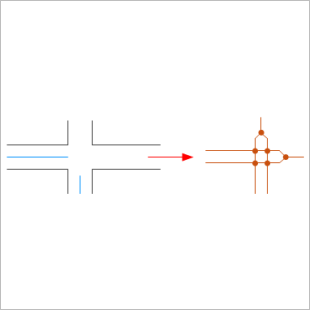
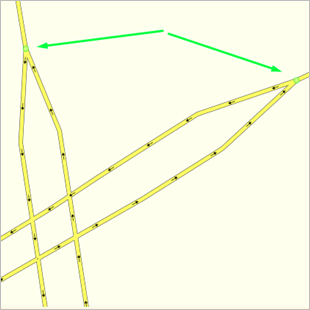


- 3.3.1.5.3.3
-
If a two-lane road forms a T-shaped intersection with a one-lane road, then the former will not converge into a one-lane road:
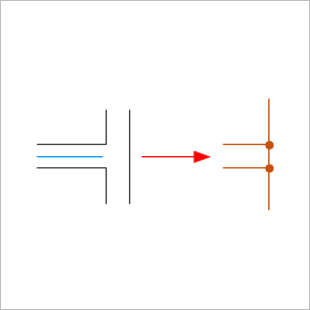
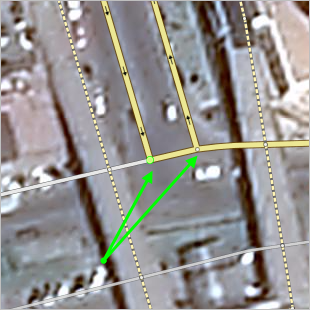


- 3.3.1.5.3.4
-
If the intersection has two-lane roads and barriers, then draw the intersection to reflect where vehicles can actually pass through:
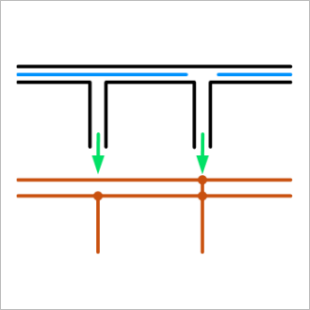
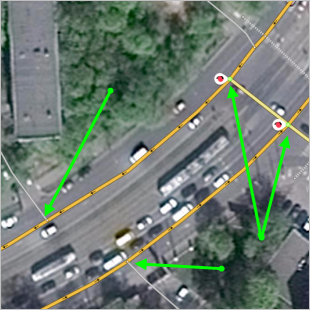
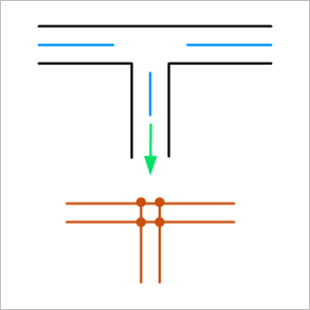
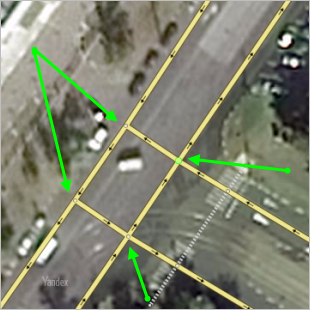
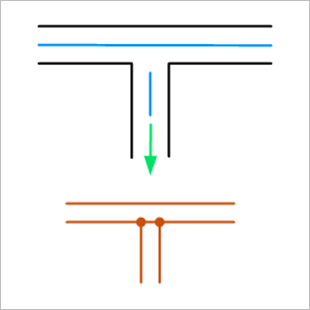
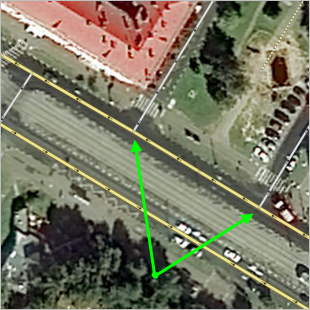
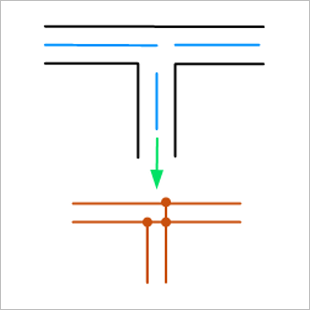
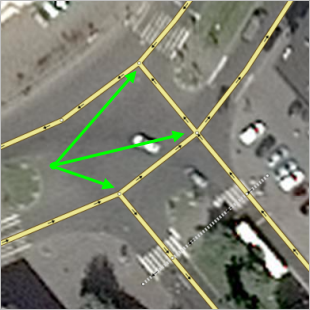








- 3.3.1.5.4
-
At T-shaped intersections, draw roads without excessive curvature or roundness, even if they are present at the physical location. The green arrows on the left indicate an intersection that was drawn correctly. The red arrows indicates an incorrectly drawn intersection. On the right, an incorrect drawing was corrected:
Correct and incorrect Correct 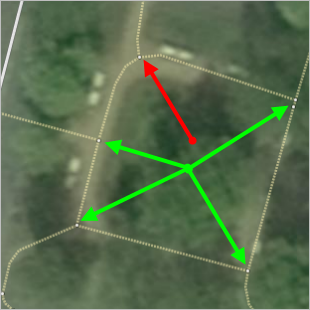
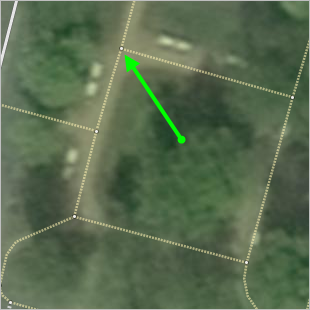
Correct and incorrect Correct 

This rule applies to all classes of roads, including pedestrian paths. Draw intersections where a high-class road turns and adjoins a less significant road in a similar fashion.
Correct Incorrect 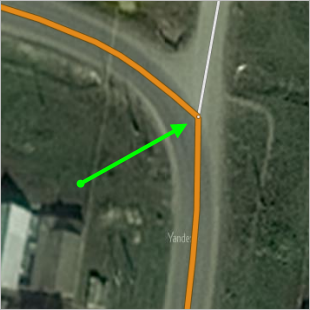
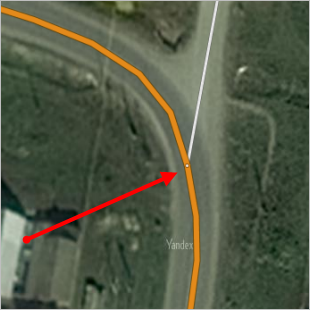
Correct Incorrect 

Turns are only drawn as smooth curves in cases where there is a physical divider or a corresponding marker on the map:
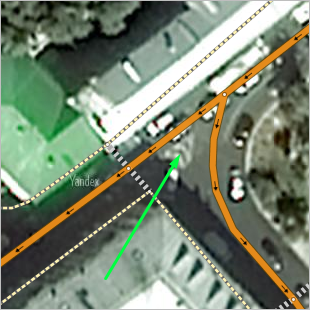
We recommend connecting the sections of the road network at T-intersections at right angles, but this isn't mandatory.
Correct drawing Acceptable drawing 

Correct drawing Acceptable drawing 

- 3.3.1.5.5
-
Circular road sections should not share intersection points:
3.3.1.6. Drawing rules for sidewalks, pedestrian paths, and bike paths
- 3.3.1.6.1
-
The Pedestrian paths class comprises the following:
Roads that are not wide enough for vehicles
Pedestrian paths
Sidewalks
Roads within parks and cemeteries
Pedestrian walkways across railway tracks and motorways
Pedestrian staircases, bridges, and tunnels
Note.When you draw pedestrian roads and sidewalks, you can use road color-coding to represent Pedestrian accessibility (in other words, use different colors to show whether or not a road is accessible to pedestrians).
Do not draw too many unpaved pedestrian roads (paths) on a restricted area (for example, in a single courtyard), even if they can be discerned from a satellite image. It is necessary to single out the key points among them (providing access to public service points, public transport stops, etc.) and draw only them.
Note.Significant pedestrian paths (such as Arbat St. in Moscow) are class “7 (Streets in localities”); set the access as pedestrian-only for them.
- 3.3.1.6.1.1
-
Don't draw items that resemble sidewalks or pedestrian paths but do not function as such (for example, commercial passageways):
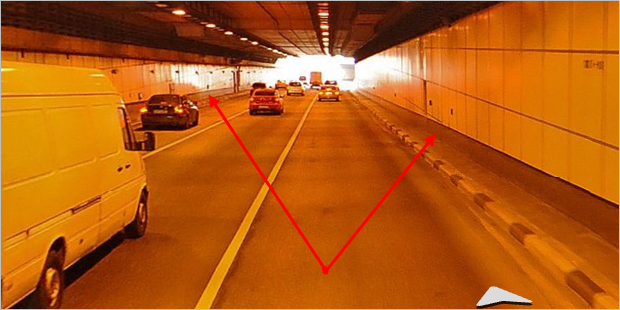
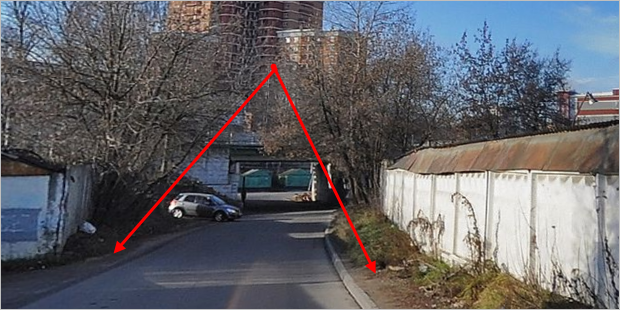
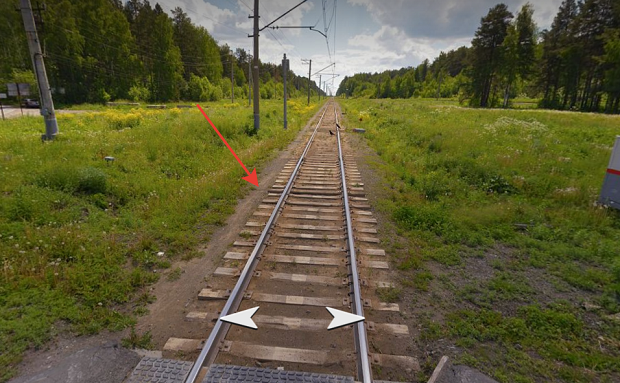
- 3.3.1.6.1.2
-
Sidewalks, pedestrian and Bicycle paths are drawn on a conditional basis. “axial” lines.
If an areal item is inaccessible to cars and has no visible “axial” pedestrian path lines, it should be drawn along the shortest path and at right angles if possible. You can also draw additional pedestrian paths along the perimeter of the areal item.
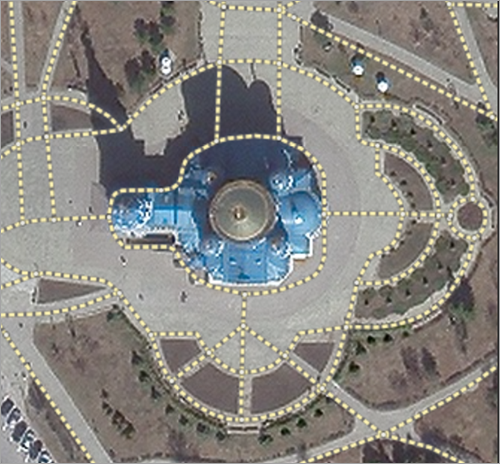
- 3.3.1.6.2
-
Lines representing pedestrian crosswalks, sidewalks, and pedestrian zones should form a connected network with the entire road network as a whole.
Networks of alleys and pedestrian roads running through parking lots and cemeteries should connect in the proper location to sidewalks and motorways that have the accessible to pedestrian attribute marked.
For example, the solid green line indicates a sidewalk in the drawing, the dotted line represents a network of pedestrian paths in a cemetery, and the brown line — a section of motorway. The red arrow indicates the point where they intersect. A fragment of the broader road graph is displayed on the drawing:
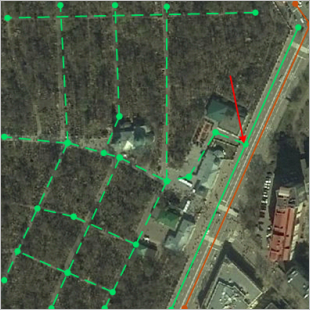
- 3.3.1.6.3. Sidewalks
-
- 3.3.1.6.3.1
-
Draw sidewalks as separate roads if the sidewalk is separated from the roadway by a physical barrier (such as a lawn, chainlink fence, or other fence). Chainless posts between the road and the sidewalk are not considered physical barriers.
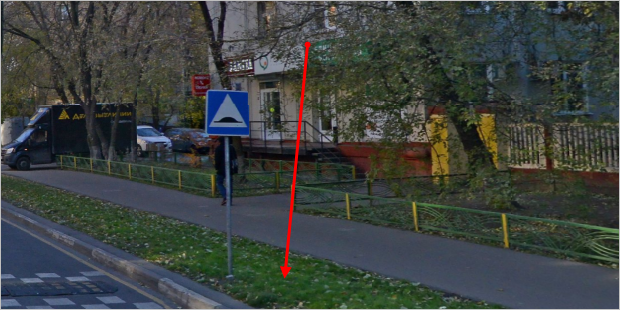
Draw sidewalks that are only separated from the road by the curb as separate roads running alongside roads of class 1-7:
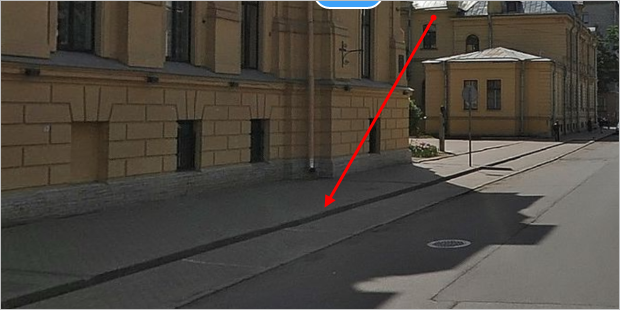
Sidewalks along class 8 roads are drawn with a separate line provided that there's a perpendicular or angled parking between the sidewalk and the road.
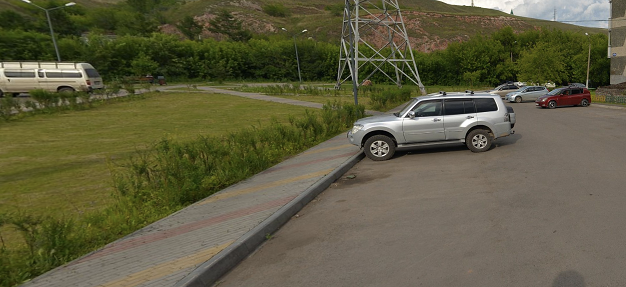
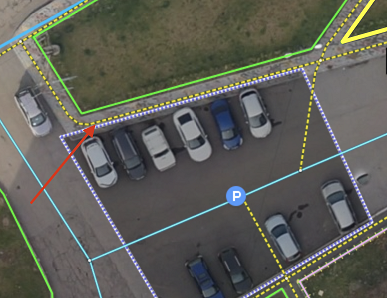
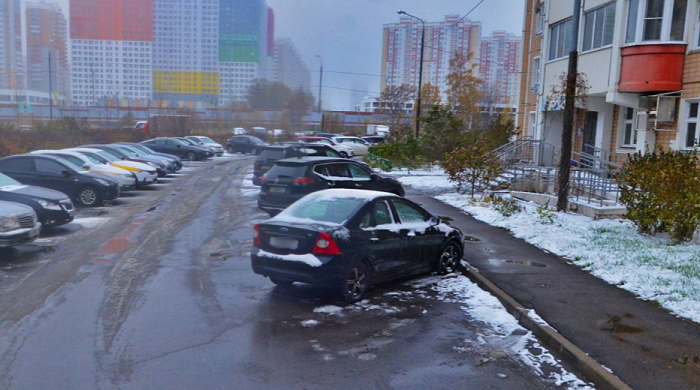
You can draw a sidewalk as a separate line of the road network in places where pedestrians access the territory through a gate (in addition, mark the gate as an entry/exit restriction).
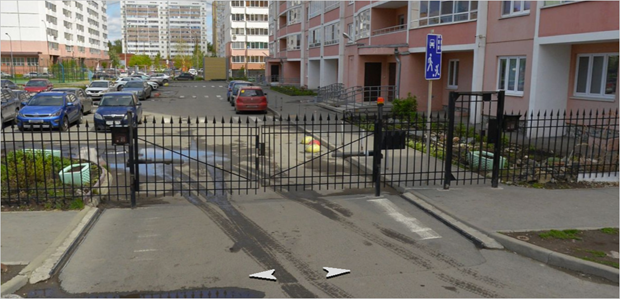
You can draw a separate line for the sidewalk in this case, but it's not mandatory.
- 3.3.1.6.3.2
-
The shoulder of a highway is not considered to be a sidewalk; do not draw it as a separate road.
If the shoulder of a road segment is accessible to pedestrians, then don't draw it as a sidewalk running along that segment, but rather add the accessible to pedestrian attribute to the applicable segment.
- 3.3.1.6.3.3
-
To ensure connectivity of the road network in areas where the pavement ends, but the further movement of pedestrians is possible on the side of the road, should smoothly join the line of the sidewalk and the road segment pedestrian road (in the picture the green dotted line):
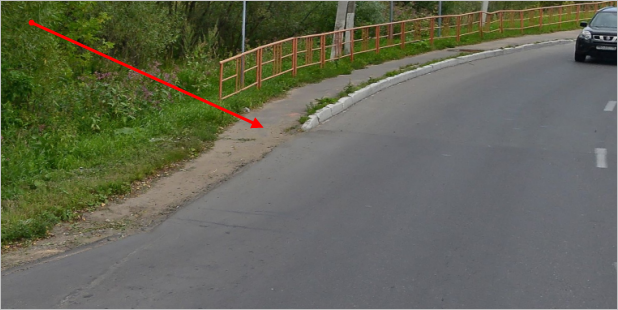
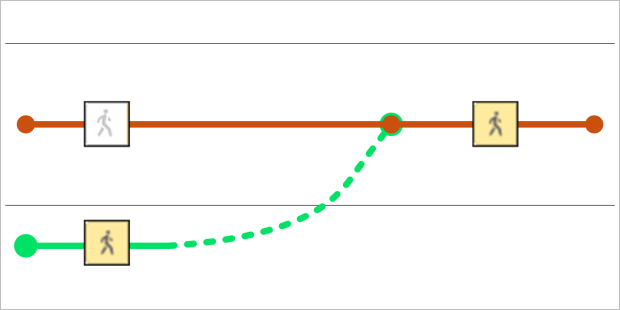
- 3.3.1.6.3.4
-
If there are no pedestrian overpasses or pedestrian underpasses, as well as no signs or markings on the intersections (“zebras”), the pedestrian road passes through the intersection as an extension of the sidewalk line in the following cases:
The roadway(s) of the intersected road has 3 traffic lanes or less.
The intersected road does not have a solid center line:
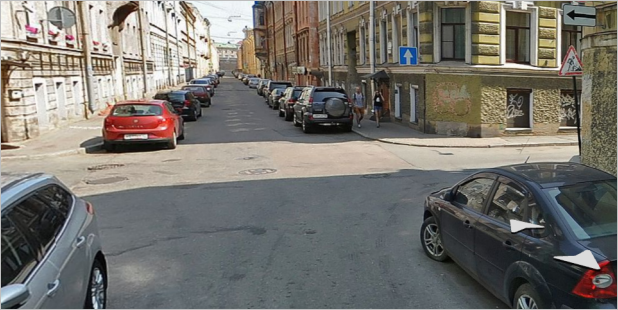
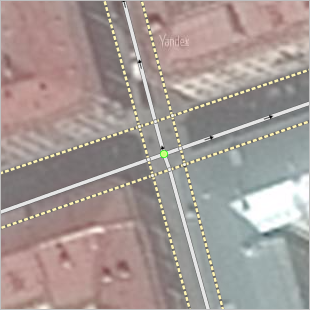
- 3.3.1.6.3.5
-
In places where a pedestrian road approaches a car road, you can draw the intersection the following ways:
Along the pedestrian crosswalk (if there is one)
With no pedestrian crosswalk (if the intersecting motorway has no solid lane marker):
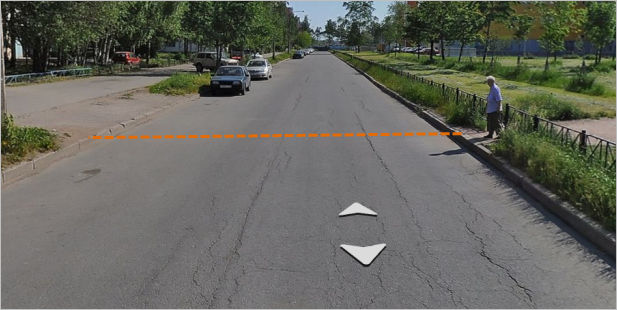
If the intersecting motorway has a solid lane marker, then you can draw the pedestrian road either as a separate road leading to the closest pedestrian crosswalk, or (if there is no road shoulder) you can draw it as a dead end:
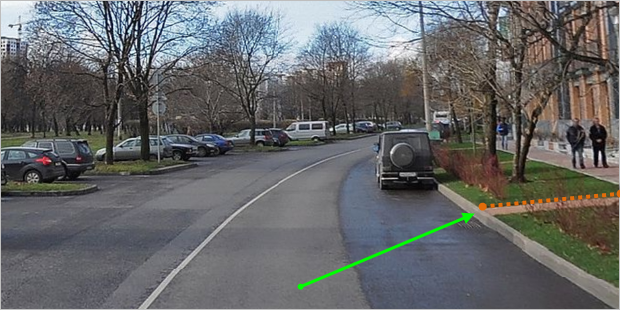
- 3.3.1.6.3.6
- If part of the road network accessible to pedestrians is isolated from the larger road network accessible to pedestrians (for example, industrial zone roads facing a street without a sidewalk and curb on one side), it is allowed to draw a pathway: a class 10 intersecting road accessible to pedestrians, which will connect the isolated section of the road network to the sidewalk.
- 3.3.1.6.3.7
-
You can map roads located at different levels that provide a quick passage between the airport building and its infrastructure (such as a parking lot).
Roads inside and outside the building that go on any level except the first one must have a level different from 0 and connect to the main road network.
- 3.3.1.6.4. Pedestrian crosswalks
-
- 3.3.1.6.4.1
-
Draw lines representing pedestrian crosswalks down the middle of the crosswalks themselves.
- 3.3.1.6.4.2
-
If the pedestrian crosswalk ends at a square that is accessible to pedestrians, then the points where the crossing ends and the entrance to the square begins are connected using segments of hypothetical pedestrian paths. Draw these paths at right angles from each other (if possible) and keep their use to a minimum.
Pedestrian roads display as yellow lines in the drawing, underground crossings — yellow dotted lines, hypothetical connecting paths — green lines:
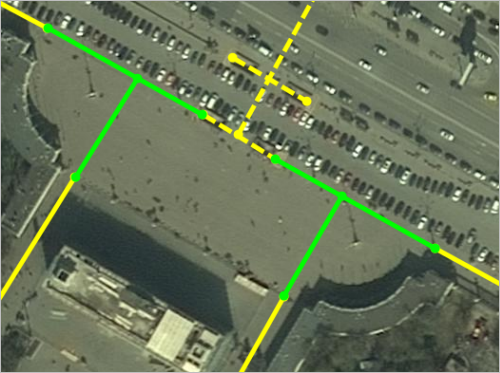
- 3.3.1.6.4.3
-
Lines for aboveground and underground pedestrian crosswalks lead to the point where the ascent/descent begins (if the ascent/descent includes section of level ground, simplify your drawing so that there are no more than two sections):
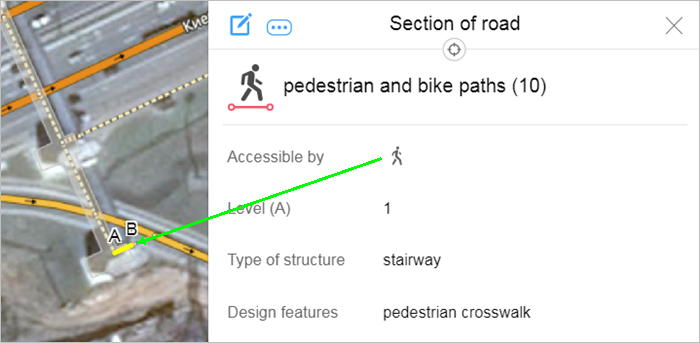
- 3.3.1.6.4.4
-
Draw double pedestrian crosswalks (i.e. when two “zebra crossings” are located close to each other and you can only go in one direction on each of them) as a single line with the direction of traffic going both ways.
- 3.3.1.6.4.5
-
Only draw pedestrian crosswalks over railways in the following cases:
- If the crosswalk is aboveground
- If the crosswalk is underground
- If the crosswalk is clearly delineated at ground level (with barriers, a surface covering)
- 3.3.1.6.4.6
-
When drawing pedestrian crossings, you can either highlight short road sections that connect the crossing to the road network but aren't actually part of the crossing, or include them in the pedestrian crossing:
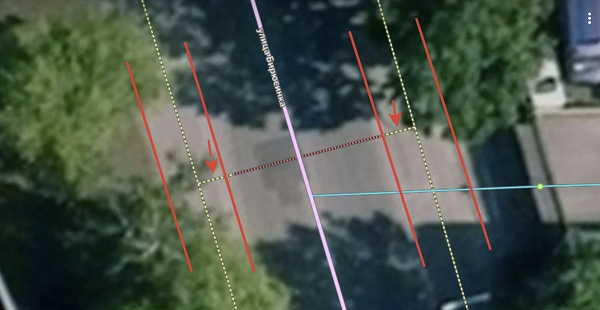
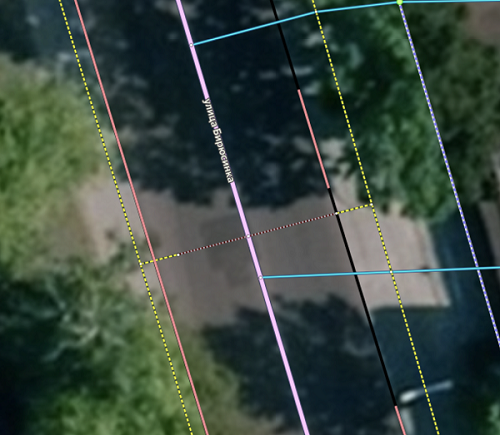
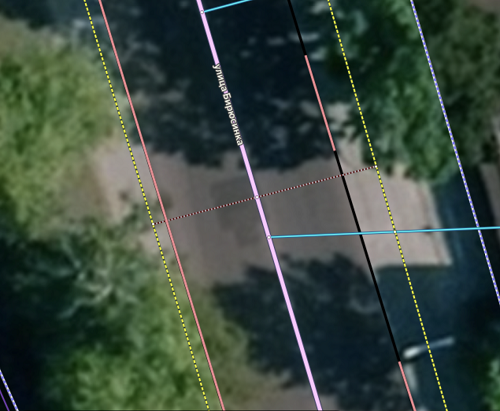
- 3.3.1.6.5. Bike paths
-
Only draw bike paths as separate roads in cases where they are physically distinguished from the surrounding area as bike paths and road signs/markings confirm this:
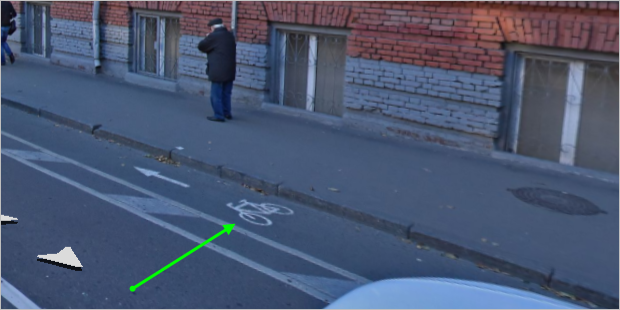
In all other cases it is enough to set the Accessible to bicyclists attribute for those sections of motorway (or pedestrian) roads.
If there is unrestricted access to a bike path from a pedestrian road/sidewalk, then the pedestrian roads connected to that sidewalk must lead to the bike path (and you should not change their accessibility marking):
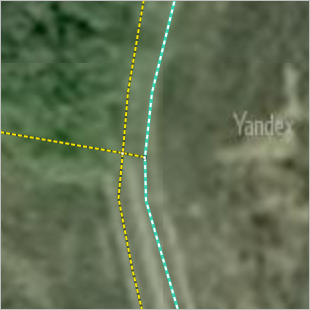
The seasonal attribute is used to label temporary bike paths in the data (editing is only available to employees).
This attribute is enabled for designated on-site bike paths that have a documented location and use span.
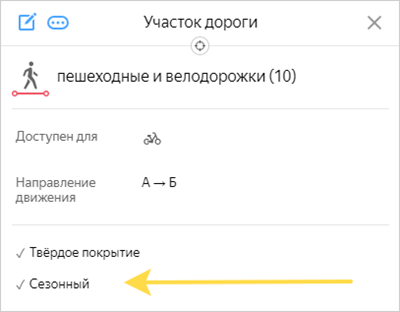
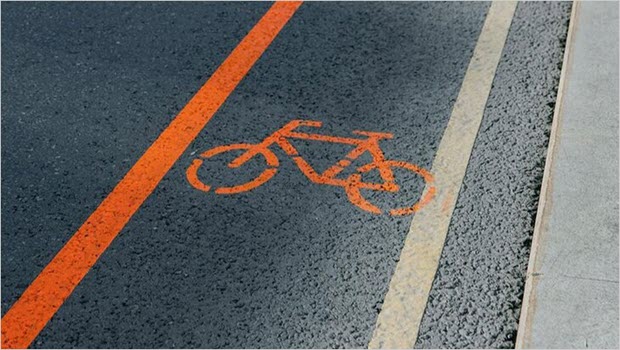 Attention.
Attention.When drawing or editing the attributes of these bike paths, bike accessibility on nearby roads doesn't change and is set in accordance with the general rules for attributing similar items.
- 3.3.1.6.6
-
If a pedestrian road passes through the interior of a building, you should only draw the road if the building it passes through is a security checkpoint leading to a restricted area that belongs to an organization.
For example:
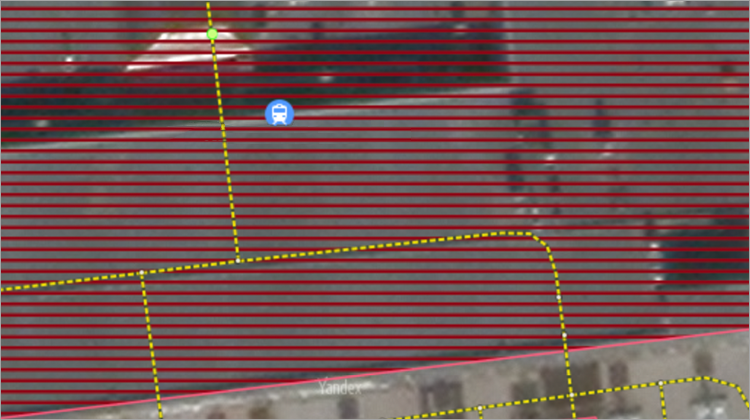
3.3.1.7. Rules for drawing seasonal roads
Seasonal roads include ferry and ice crossings, and winter roads.
Due to the complete or partial absence of seasonal roads in satellite images, draw them based on your personal knowledge of the crossing's location and official information confirming their existence and indicating the points of departure and destination.
- 3.3.1.7.1
- Ferry crossings are assigned the “ferry crossing” value for the Type of structure attribute. For ice crossings and winter roads, this attribute is left blank (its value is set to “No”).Note.
If a section of the road network is included in both ferry and ice crossings at the same time, the value of the attribute Type of structure is set as “ferry crossing” in the summer and disabled when the ferry crossing is closed.
- 3.3.1.7.2
-
For named seasonal roads, an “official” name can be indicated. In this case, the name “for caption on map” is not assigned. See 3.3.3.3.3.4. Highways without a number, but with a proper name.
- 3.3.1.7.3
-
If ice and ferry crossings operate seasonally on the same route (the starting and ending points of the ice and ferry crossings are the same), or their routes are in close proximity to one another, then these items should include the same sections of the road network.
- 3.3.1.7.4
-
Don't draw pedestrian paths that are formed and available only in winter.
For example, ski trails and paths that pass through reservoirs.
